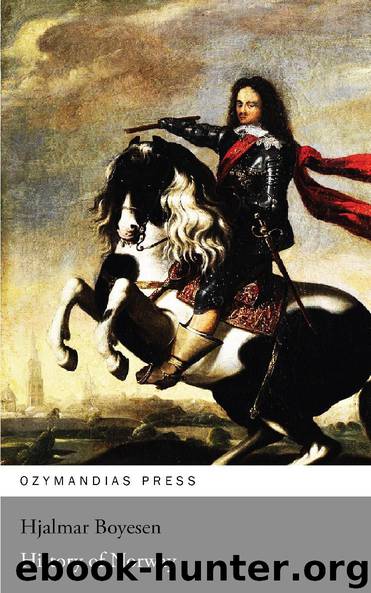History of Norway by Hjalmar Boyesen

Author:Hjalmar Boyesen
Language: eng
Format: epub
Publisher: Ozymandias Press
OLAF THE QUIET (KYRRE) (1066-1093) AND MAGNUS HAROLDSSON (1066-1069)
~
ON HIS RETURN TO NORWAY, Olaf Haroldsson found his elder brother Magnus, who had already been acknowledged as king before his father’s death, in possession of the government. After some negotiations it was agreed that the two brothers should divide the kingdom between them—Magnus taking the larger portion toward the north and west, and Olaf contenting himself with Viken. If this division was founded upon the equal allodial rights of the brothers, it was obviously unfair. But Olaf, being averse to quarrelling, accepted it, as far as we know, without protest.
The campaign to England had largely exhausted the resources of the country; and Sweyn Estridsson of Denmark thought that the opportunity was now favorable for avenging the wrongs which he had suffered at the hands of King Harold. The brothers then made levy in mass from all the country, but Sweyn succeeded in engaging Olaf with his division of the fleet, off the coast of Halland (1067), before Magnus had joined him. The battle must have been indecisive; for both sides claimed a victory. It is, how ever, probable that Olaf suffered the more, as he was the first to propose peace. Magnus had, in the meanwhile, come, and their allied fleets were, in all probability, equal or superior to Sweyn’s. At all events, Sweyn had suddenly lost the desire to prosecute the war; and a peace was made at Konghelle (1068), at which assurances of friendship and good-will were exchanged. Olaf is said to have borne his part in the negotiations with a firmness and intrepidity which inspired Sweyn with respect. As a first result of the meeting, two marriages were arranged, viz.: one between Harold Hard-ruler’s widow, Ellisif, and King Sweyn, and the other between Olaf and Sweyn’s daughter, Ingrid.
It is not known whether Magnus was present at the peace of Konghelle. If he was, his ill health must have prevented him from transacting any business; for only Olaf’s name is mentioned in connection with the treaty. During the following year, too, all public business devolved upon Olaf; for Magnus lay ill in Nidaros and finally died in the spring, 1069. He left one son, Haakon, who was but an infant and was fostered by Thore of Steig. No one put forth any claim to the kingdom in his name, and Olaf thus became king of the whole country.
With the exception of the little ripple of martial excitement during the first years after his accession, Olaf Haroldsson’s reign of twenty-seven years presents not a single warlike event. His saga is a saga of peace—a long and honorable record of achievements in the service of civilization. The key-note of his character was prudent moderation. He was religious, but not fanatical; devout, but not bigoted. Easy-going by temperament, yet negligent of no duty, cheerful but not jolly, calm but not indolent, he is indeed a unique but none the less attractive figure among the martial descendants of Harold the Fairhaired. He is
Download
This site does not store any files on its server. We only index and link to content provided by other sites. Please contact the content providers to delete copyright contents if any and email us, we'll remove relevant links or contents immediately.
East of Eden by John Steinbeck(2736)
A Forest Journey by John Perlin(2588)
Atlas Obscura by Joshua Foer(2351)
Merriam-Webster's Collegiate Thesaurus, Second Edition by Merriam-Webster Inc(2333)
Tokyo by Rob Goss(2022)
Stone Building by Kevin Gardner(1997)
Futebol by Alex Bellos(1795)
A History of Warfare by John Keegan(1721)
Top 10 Dubai and Abu Dhabi by DK Travel(1718)
Lonely Planet Australia by Lonely Planet(1679)
Beyond the Coral Sea by Michael Moran(1627)
Discover Australia by Lonely Planet(1588)
Lonely Planet's Guide to Travel Photography by Lonely Planet(1570)
Rick Steves London 2018 by Rick Steves & Gene Openshaw(1494)
Deep South by Paul Theroux(1477)
Lonely Planet Maldives (Travel Guide) by Planet Lonely & Masters Tom(1431)
Lonely Planet Guatemala by Lonely Planet(1391)
Blue Highways by William Least Heat-Moon(1382)
Borneo Travel Guide by Lonely Planet(1353)
